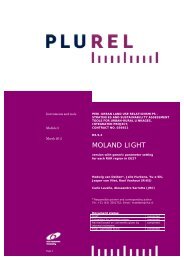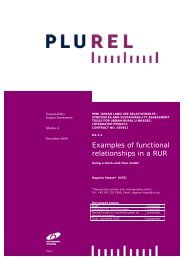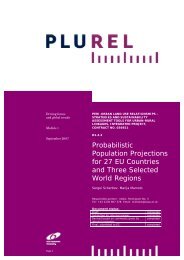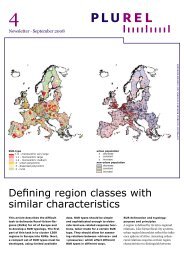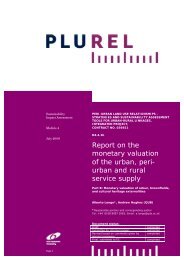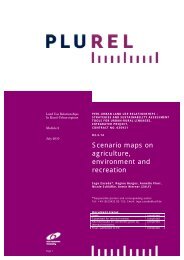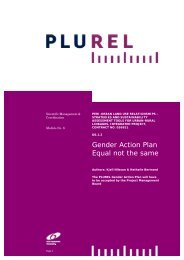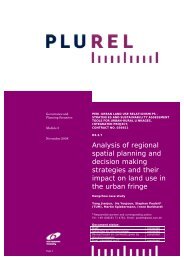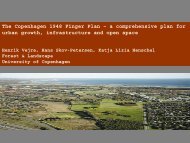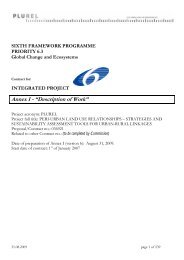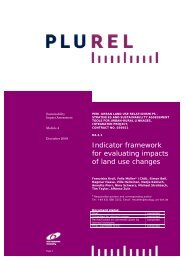Cost benefit analysis of peri-urban land use policy - Plurel
Cost benefit analysis of peri-urban land use policy - Plurel
Cost benefit analysis of peri-urban land use policy - Plurel
You also want an ePaper? Increase the reach of your titles
YUMPU automatically turns print PDFs into web optimized ePapers that Google loves.
Scenarios for the GDA<br />
Within the framework <strong>of</strong> Strategic Environment Assessment for the GDA, three scenarios are subject<br />
to evaluation including: 1) Business-as-usual scenario 2) Finger expansion scenario 3) Consolidation<br />
scenario.<br />
Scenario 1: Business-As-Usual<br />
In this scenario, current trends in <strong>land</strong> zoning, <strong>land</strong> development and transportation are continuing<br />
with a limited implementation <strong>of</strong> Transport 21 project (see Figure 3) and planning/<strong>policy</strong> decisions<br />
stated in the RPGs (2004). This implies that proposed growth nodes <strong>of</strong> the RPGs are not supported<br />
by the necessary public transportation networks and/or <strong>land</strong> zoning decisions and implementations.<br />
In the Regional plan, the primary and the secondary growth nodes are attached the role <strong>of</strong> selfcontainment,<br />
and will be separated from each other by greenbelts surrounding them. Since there is<br />
limited integrated transportation/<strong>land</strong>-<strong>use</strong> planning supporting the development <strong>of</strong> the primary<br />
growth nodes; this situation acts as an obstacle in this scenario for the development <strong>of</strong> the new<br />
growth centres. Consequently, new development spreads to the outskirts <strong>of</strong> the existing development<br />
where there is abundant <strong>of</strong> greenfield <strong>land</strong> at lower prices. The final result is dispersed type <strong>of</strong><br />
settlements around the Dublin Region with high employment dependency on the core <strong>of</strong> the Dublin<br />
Area (see Figure 4).<br />
Increase in car dependency associated with dispersed development and the resultant increase in<br />
traffic congestion are some problems seem to have significant impacts in the GDA. Low density and<br />
private car dependent developments -as the sprawl patterns in this scenario-are less accessible,<br />
requiring more travel to reach <strong>urban</strong> activities, and reducing transportation options i.e. cycling,<br />
pedestrian and public transit access. The result is the increase in transportation costs-both <strong>use</strong>r costs<br />
and external costs. Furthermore, the characteristic <strong>of</strong> dispersed development in this scenario is seen<br />
to be unsustainable considering that it necessitates providing infrastructure and services to the low<br />
density population on <strong>urban</strong> <strong>peri</strong>phery reflecting the main cost <strong>of</strong> infrastructure provision on the<br />
society as a whole. It also ca<strong>use</strong>s loss in productive agricultural <strong>land</strong> and reduction <strong>of</strong> <strong>land</strong>scape<br />
amenity, and related to indirect externalities such as: negative effects on air/water quality, increased<br />
accessibility costs, and unwanted social equity costs.<br />
67



